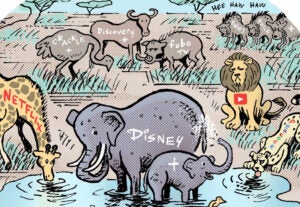 The world of data-driven display media is not just about non-guaranteed, remnant media. It’s about guaranteed, too.
The world of data-driven display media is not just about non-guaranteed, remnant media. It’s about guaranteed, too.
Lowell Simpson, Chief Data Solutions Officer at GroupM media agency Mediacom, teamed with Yoav Arnstein of Legolas and discussed the world of data and online media – especially as it relates to brands – at last Thursday’s session of TARGUSinfo’s Interactive Insights Summit in Las Vegas.
Simpson crystallized for the audience a comprehensive list of challenges for remnant and guaranteed buying in combination with data to effect successful campaigns on behalf of brands – challenges that many of his competitors can likely relate to.
We list a few of them here for your viewing pleasure along with excerpts of Simpson’s commentary.
Minimal Reach and Spend Forecasting
“There are a lot of the limitations for our brands in terms of buying this way – in particular, minimal reach and spend forecasting is probably the number one. As you all know, margins have been decreasing. Budgets are as volatile as the stock market has been over the last couple of years. And, the first thing that gets cut when the economy is down is advertising spend.
(…) With our clients it’s a procurement world. Nobody likes going back to procurement twice for that money. We try to do things on our side to stagnate that away. [Still,] this type of buying does give us a problem with our clients.”
Rich Media
“We can’t do some of the core things that we like to do that our clients like expandables (…).
For a major theatrical client, they really can’t do exchange‑based buying, because they want to see their previews on their ads. That limits them tremendously in terms of their ability to use [data-driven buying].”
Brand Safety
“Obviously brand safety is a huge thing. A lot of times our planners (…) get emails every day of sites that we’ve never purchased on. Sometimes we don’t have the visibility of those sites from the vendors, and that’s another big issue.”
Data Integrity
“Our data integrity is a huge problem. We are firm believers in ‘the sell’ of what we are buying. And a lot of times we are caught in a rub with data integrity in terms of where our performance is…”
Ad Server Cost
“Because of the increased volume and low media cost, the one thing that hasn’t changed is the ad server cost. The clients are shooting through their ad serving budgets with these [data-driven] buys all day. It has become a huge issue. Clients are not willing to give up ad serving from a third party for the sake of doing these buys. They’ll cut the budgets entirely.
…We’re trying to figure out how to make it work. It’s becoming very difficult. There are not many [vendors] out there that I’ve seen, that have a dedicated ad server along with a capability to do real‑time bidding.”
Fragmentation of Planning and Buying
“Our planners will work on a new plan for two months for a big campaign. And when the buyers get a hold of it, they do their buying. When we actually do a regroup at the end of the campaign and we look against the plan, and the buy does not match the plan.
… There’s not a lot of discussion between the planners and the buyers in terms of why we’re doing things [a certain] way. Then it becomes a communication nightmare.”
Data-driven display at scale is not easy.
By John Ebbert













